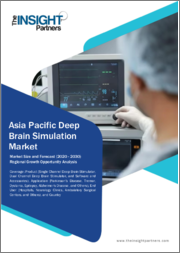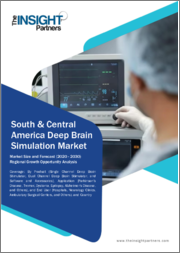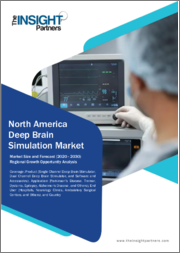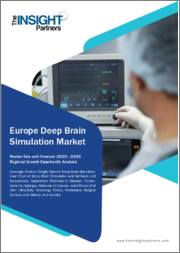
|
시장보고서
상품코드
1402481
아시아태평양의 뇌심부 자극치료 시장 예측(-2030년) : 지역별 분석 - 제품, 용도, 최종사용자별Asia Pacific Deep Brain Simulation Market Forecast to 2030 - Regional Analysis - by Product, Application, and End User |
||||||
아시아태평양의 뇌심부 자극치료 시장은 2022년 9,835만 달러에서 2030년에는 1억 8,804만 달러로 성장할 것으로 예측되고 있습니다. 2022-2030년의 CAGR은 8.4%로 추정됩니다.
심부뇌자극에서 기술의 진보와 승인이 아시아태평양의 뇌심부 자극치료 시장을 촉진
로봇 이식, 다중 대상 자극, 미세전극 설계 개선, 충전식 펄스 발생기, 개별화된 대상 프로그래밍 등은 뇌심부자극치료(DBS)의 기술 발전 중 하나입니다. 이러한 발전으로 DBS 장비는 기존 방식에 비해 부작용이 적고, 파킨슨병 환자의 효과와 증상 완화를 개선하고 있습니다. Abbott의 Infinity Deep Brain Stimulation System은 환자의 증상 관리를 돕는 새로운 DBS 기술입니다. 2020년 2월에 발표된 MGM Medical의 보도자료에 따르면 타밀나두의 MGM Medical은 강박장애(OCD)에 대한 첫 번째 뇌심부자극요법 치료제로서, 효율적이고 맞춤 치료 관리를 제공하고 부작용의 위험을 줄인 최초의 무선 iOS 소프트웨어 DBS 모바일 플랫폼입니다.에 대한 최초의 뇌심부자극요법(DBS)을 시행했습니다. 따라서 DBS의 기술 발전은 예측 기간 중 아시아태평양의 심부 뇌 자극 시장에 기회를 창출할 것으로 예상됩니다.
아시아태평양의 뇌심부자극치료 시장 개요
중국은 세계에서 가장 많은 노인 인구를 보유한 국가로, The Lancet에 게재된 "China's Aging Population: Crisis or Opportunity?"(중국의 고령화: 위기인가 기회인가?)라는 제목의 연구 결과에 따르면 2019년에 중국의 60세 이상 노인 인구는 2억 5400만 명으로, 2040년에는 4억 200만 명으로 증가하여 전체 인구의 28%를 나타낼 것으로 예상했습니다. 이러한 변화는 비감염성 질환의 위험과 부담이 증가하고 의료 사회보장제도에 대한 수요도 증가하기 때문에 중국의 공중보건에 중대한 영향을 미칠 것입니다. ChinaDaily에 따르면 2023년 2월 현재 중국에는 약 400만 명의 파킨슨병 환자가 있으며, 65세 이상 인구의 1.7%가 파킨슨병 진단을 받았다고 합니다. Population, and Nutrition 저널에 게재된 연구에 따르면 중국의 알츠하이머병 환자 수는 600만 명이며, 65세, 75세, 85세의 치매 비율은 각각 5%, 11.5%, 30%입니다. 시상 하부 핵(STN)의 뇌 심부 자극(DBS)은 파킨슨 병(PD) 치료에 효과적이며, DBS 하드웨어의 발전과 함께 연구자들은 몇 가지 새로운 프로그래밍 기술을 개발했으며, 그 중 원격 프로그래밍은 중국에서 널리 사용되고 있습니다. 제품(PINS Medical, Ltd., 중국 베이징)을 사용하여 파킨슨병 환자의 원격 프로그래밍을 수행했습니다. 진행성 파킨슨병 환자(15년 이상의 시간적 시야)에게 DBS는 매우 효과적인 치료 옵션으로 여겨지고 있습니다. 그러나 DBS는 다른 선진국과 달리 보험이 적용되지 않는 경우 환자에게 큰 경제적 부담이 될 수 있습니다. 중국에서는 수술 비용은 주로 환자의 건강 보험에 의해 보장되지만 DBS 하드웨어 비용은 부분적으로만 보장되기 때문에 중국 시장 성장에 걸림돌이 될 수 있습니다.
아시아태평양의 뇌심부 자극치료 시장 매출과 2030년까지의 예측(금액)
아시아태평양의 뇌심부 자극치료 시장 세분화
아시아태평양의 뇌심부 자극치료 시장은 제품, 용도, 최종사용자, 국가로 구분됩니다.
제품별로는 아시아태평양의 뇌심부 자극치료 시장은 싱글 채널 심부뇌 자극기, 듀얼 채널 심부뇌 자극기, 소프트웨어와 액세서리로 구분됩니다. 2022년에는 듀얼 채널 심부뇌 자극기 부문이 아시아태평양의 뇌심부 자극치료 시장에서 최대 점유율을 기록했습니다.
용도별로는 아시아태평양의 뇌심부 자극치료 시장은 파킨슨병, 진전, 근육긴장이상, 간질, 알츠하이머병, 기타로 구분됩니다. 2022년에는 파킨슨병 분야가 아시아태평양의 뇌심부 자극치료 시장에서 최대 점유율을 기록했습니다.
최종사용자별로 보면 아시아태평양의 뇌심부 자극치료 시장은 병원, 신경과클리닉, 외래 수술 센터, 기타로 구분됩니다. 2022년에는 병원 부문이 아시아태평양의 뇌심부 자극치료 시장에서 최대 점유율을 기록했습니다.
국가별로 보면 아시아태평양의 뇌심부 자극치료 시장은 중국, 일본, 인도, 한국 , 호주, 기타 아시아태평양으로 구분됩니다. 2022년에는 중국 부문이 아시아태평양의 뇌심부 자극치료 시장에서 최대 점유율을 기록했습니다.
Abbott Laboratories사, Beijing PINS Medical Co Ltd사, Boston Scientific Corp사, Medtronic Plc사, SceneRay Co Ltd는 아시아태평양의 뇌심부 자극치료 시장에서 사업을 운영하고 있는 대기업입니다.
목차
제1장 서론
제2장 주요 요약
- 주요 인사이트
- 아시아태평양의 뇌심부 자극치료 시장 : 지역별
제3장 조사 방법
- 조사 범위
- 2차 조사
- 1차 조사
제4장 아시아태평양의 뇌심부 자극치료 시장 구도
- 서론
- 아시아태평양 PEST 분석
- 비교 분석
- 뇌심부 자극치료와 병변 형성 시술의 비교
- 신경질환에서 병변 형성 절차
- 2022년에 시행되는 아시아태평양의 뇌심부 자극치료 수술 시술 : 국가별
제5장 아시아태평양의 뇌심부 자극치료 시장 : 주요 산업 역학
- 주요 시장 촉진요인
- 신경질환의 유병률 상승
- 저침습수술의 수요
- 시장 억제요인
- 뇌심부 자극에 수반하는 부작용
- 시장 기회
- 뇌심부 자극치료에서 기술의 진보와 승인
- 향후 동향
- 연구개발의 활발화
- 영향 분석
제6장 뇌심부 자극치료 시장 : 아시아태평양 시장 분석
- 아시아태평양의 뇌심부 자극치료 시장 판매고, 2022-2030년
제7장 아시아태평양의 뇌심부 자극치료 시장 : 2030년까지의 매출과 예측 : 제품별
- 서론
- 아시아태평양의 뇌심부 자극치료 시장 : 제품별, 2022년·2030년 판매고 점유율(%)
- 싱글 채널 뇌심부 자극치료
- 듀얼 채널 뇌심부 자극치료
- 소프트웨어와 부속품
제8장 아시아태평양의 뇌심부 자극치료 시장 : 용도별 매출과 2030년까지의 예측
- 서론
- 아시아태평양의 뇌심부 자극치료 시장 : 용도별, 2022년·2030년 판매고 점유율(%)
- 파킨슨병
- 진전
- 알츠하이머병
- 근육긴장이상
- 간질
- 기타
제9장 아시아태평양의 뇌심부 자극치료 시장 : 최종사용자별 매출과 2030년까지의 예측
- 서론
- 아시아태평양의 뇌심부 자극치료 시장 : 최종사용자별, 2022년·2030년 판매고 점유율(%)
- 병원
- 신경 클리닉
- 외래 수술 센터
- 기타
제10장 아시아태평양의 뇌심부 자극치료 시장 : 국가별 분석
- 개요
- 아시아태평양의 뇌심부 자극치료 시장 : 국가별 리스트
- 중국
- 일본
- 인도
- 호주
- 한국
- 기타 아시아태평양
제11장 COVID-19 전후의 영향
- COVID-19 전후의 영향
제12장 아시아태평양의 뇌심부 자극치료 시장 업계 상황
- 서론
- 뇌심부 자극치료 시장의 성장 전략
- 유기적 성장 전략
- 개요
- 무기적 성장 전략
- 개요
제13장 뇌심부 자극치료 시장 : 주요 기업 개요
- Abbott Laboratories
- Medtronic Plc
- Beijing PINS Medical Co Ltd
- Boston Scientific Corp
- SceneRay Co Ltd
제14장 부록
KSA 24.01.16The Asia Pacific deep brain simulation market is expected to grow from US$ 98.35 million in 2022 to US$ 188.04 million by 2030. It is estimated to grow at a CAGR of 8.4% from 2022 to 2030.
Technological Advancements and Approvals in Deep Brain Stimulation Drive Asia Pacific Deep Brain Simulation Market
Robotic implantation, multi-target stimulation, improved microelectrode designs, rechargeable pulse generators, and personalized, targeted programming are among the technological advancements in deep brain stimulation (DBS). Owing to these advancements, DBS devices show fewer side effects and improved efficacy and symptom relief in Parkinson's patients compared to traditional methods. Abbott's Infinity Deep Brain Stimulation System is a technologically advanced new DBS that helps the patients manage their symptoms. It is the first wireless iOS software DBS mobile platform that has offered efficient and personalized therapy management with reduced risk of side effects. According to the MGM Healthcare press release published in February 2020, MGM Healthcare, Tamil Nadu, performed its first deep brain stimulation (DBS) for obsessive-compulsive disorder (OCD). Therefore, technological advancements in DBS are expected to create opportunities for the Asia Pacific deep brain stimulation market during the forecast period.
Asia Pacific Deep Brain Simulation Market Overview
China is home to the world's largest population of older adults. According to a study published in The Lancet titled "China's Aging Population: Crisis or Opportunity?" in 2019, people in China aged 60 or older were ~254 million. By 2040, that number is expected to rise to 402 million, ~28% of the population. These changes have profound public health implications in the country as the risk and burden of noncommunicable diseases increase along with the demand for health and social care systems. Parkinson's disease (PD) is a common neurodegenerative disease in the country. According to ChinaDaily, there were approximately 4 million Parkinson's patients in China as of February 2023, and ~1.7% of people over 65 years have been diagnosed with the disease. According to a study discussed in the Journal of Health, Population, and Nutrition, the number of people with Alzheimer's disease in China is ~6 million, with dementia rates among 65-, 75-, and 85-year-olds being 5%, 11.5%, and 30%, respectively. Deep brain stimulation (DBS) of the subthalamic nucleus (STN) is effective in the treatment of Parkinson's disease (PD). With advancements in DBS hardware, researchers have developed several novel programming technologies, of which remote programming is widely used in China. Since 2018, we have been performing remote programming for patients suffering from PD using PINS products (PINS Medical, Ltd., Beijing, China). For patients with advanced Parkinson's disease (over a 15-year time horizon), DBS is considered to be a highly effective treatment option. However, DBS remains a significant economic burden on the patient when not reimbursed, unlike in any other developed country. In China, the surgery cost is mainly covered by the patient's health insurance, but the cost of DBS hardware is only partially covered, which can hamper the growth of the market in the country.
Asia Pacific Deep Brain Simulation Market Revenue and Forecast to 2030 (US$ Million)
Asia Pacific Deep Brain Simulation Market Segmentation
The Asia Pacific deep brain simulation market is segmented into product, application, end user, and country.
Based on product, the Asia Pacific deep brain simulation market is segmented into single channel deep brain stimulator, dual channel deep brain stimulator, and software and accessories. In 2022, the dual channel deep brain stimulator segment registered the largest share in the Asia Pacific deep brain simulation market.
Based on application, the Asia Pacific deep brain simulation market is segmented into Parkinson's disease, tremor, dystonia, epilepsy, Alzheimer's disease, and others. In 2022, the Parkinson's disease segment registered the largest share in the Asia Pacific deep brain simulation market.
Based on end user, the Asia Pacific deep brain simulation market is segmented into hospitals, neurology clinics, ambulatory surgical centers, and others. In 2022, the hospitals segment registered the largest share in the Asia Pacific deep brain simulation market.
Based on country, the Asia Pacific deep brain simulation market is segmented into China, Japan, India, South Korea, Australia, and the Rest of Asia Pacific. In 2022, China segment registered the largest share in the Asia Pacific deep brain simulation market.
Abbott Laboratories, Beijing PINS Medical Co Ltd, Boston Scientific Corp, Medtronic Plc, and SceneRay Co Ltd are some of the leading companies operating in the Asia Pacific deep brain simulation market.
Reasons to Buy:
- Save and reduce time carrying out entry-level research by identifying the growth, size, leading players, and segments in the Asia Pacific deep brain simulation market.
- Highlights key business priorities in order to assist companies to realign their business strategies
- The key findings and recommendations highlight crucial progressive industry trends in the Asia Pacific deep brain simulation market, thereby allowing players across the value chain to develop effective long-term strategies
- Develop/modify business expansion plans by using substantial growth offering developed and emerging markets
- Scrutinize in-depth Asia Pacific market trends and outlook coupled with the factors driving the deep brain simulation market, as well as those hindering it
- Enhance the decision-making process by understanding the strategies that underpin commercial interest with respect to client products, segmentation, pricing, and distribution
Table Of Contents
1. Introduction
- 1.1 The Insight Partners Research Report Guidance
- 1.2 Market Segmentation
2. Executive Summary
- 2.1 Key Insights
- 2.2 Asia Pacific Deep Brain Stimulation Market, by Region (US$ Million)
3. Research Methodology
- 3.1 Coverage
- 3.2 Secondary Research
- 3.3 Primary Research
4. Asia Pacific Deep Brain Simulation Market Landscape
- 4.1 Overview
- 4.2 Asia Pacific PEST Analysis
- 4.3 Comparison Analysis
- 4.3.1 Comparison of Deep Brain Stimulation and Lesioning Procedures
- 4.3.2 Lesioning Procedures in Neurological Disorders
- 4.3.3 Asia Pacific Deep Brain Stimulation Surgical Procedures Performed in 2022, By Country
5. Asia Pacific Deep Brain Simulation Market - Key Industry Dynamics
- 5.1 Key Market Drivers:
- 5.1.1 Rising Prevalence of Neurological Disorders
- 5.1.2 Demand for Minimally Invasive Surgery
- 5.2 Market Restraints
- 5.2.1 Side Effects Associated with Deep Brain Stimulation
- 5.3 Market Opportunities
- 5.3.1 Technological Advancements and Approvals in Deep Brain Stimulation
- 5.4 Future Trends
- 5.4.1 Growing Research and Development Activities
- 5.5 Impact Analysis
6. Deep Brain Simulation Market - Asia Pacific Market Analysis
- 6.1 Asia Pacific Deep Brain Simulation Market Revenue (US$ Mn), 2022 - 2030
7. Asia Pacific Deep Brain Simulation Market - Revenue and Forecast to 2030 - by Product
- 7.1 Overview
- 7.2 Asia Pacific Deep Brain Simulation Market Revenue Share, by Product 2022 & 2030 (%)
- 7.3 Single Channel Deep Brain Stimulator
- 7.3.1 Overview
- 7.3.2 Single Channel Deep Brain Stimulator: Asia Pacific Deep Brain Simulation Market - Revenue and Forecast to 2030 (US$ Million)
- 7.4 Dual Channel Deep Brain Stimulator
- 7.4.1 Overview
- 7.4.2 Dual Channel Deep Brain Stimulator: Asia Pacific Deep Brain Simulation Market - Revenue and Forecast to 2030 (US$ Million)
- 7.5 Software and Accessories
- 7.5.1 Overview
- 7.5.2 Software and Accessories: Asia Pacific Deep Brain Simulation Market - Revenue and Forecast to 2030 (US$ Million)
8. Asia Pacific Deep Brain Simulation Market - Revenue and Forecast to 2030 - by Application
- 8.1 Overview
- 8.2 Asia Pacific Deep Brain Simulation Market Revenue Share, by Application 2022 & 2030 (%)
- 8.3 Parkinson's Disease
- 8.3.1 Overview
- 8.3.2 Parkinson's Disease: Asia Pacific Deep Brain Simulation Market - Revenue and Forecast to 2030 (US$ Million)
- 8.4 Tremor
- 8.4.1 Overview
- 8.4.2 Tremor: Asia Pacific Deep Brain Simulation Market - Revenue and Forecast to 2030 (US$ Million)
- 8.5 Alzheimer's Disease
- 8.5.1 Overview
- 8.5.2 Alzheimer's Disease: Asia Pacific Deep Brain Simulation Market - Revenue and Forecast to 2030 (US$ Million)
- 8.6 Dystonia
- 8.6.1 Overview
- 8.6.2 Dystonia: Asia Pacific Deep Brain Simulation Market - Revenue and Forecast to 2030 (US$ Million)
- 8.7 Epilepsy
- 8.7.1 Overview
- 8.7.2 Epilepsy: Asia Pacific Deep Brain Simulation Market - Revenue and Forecast to 2030 (US$ Million)
- 8.8 Others
- 8.8.1 Overview
- 8.8.2 Others: Asia Pacific Deep Brain Simulation Market - Revenue and Forecast to 2030 (US$ Million)
9. Asia Pacific Deep Brain Simulation Market - Revenue and Forecast to 2030 - by End User
- 9.1 Overview
- 9.2 Asia Pacific Deep Brain Simulation Market Revenue Share, by End User 2022 & 2030 (%)
- 9.3 Hospitals
- 9.3.1 Overview
- 9.3.2 Hospitals: Asia Pacific Deep Brain Simulation Market - Revenue and Forecast to 2030 (US$ Million)
- 9.4 Neurology Clinics
- 9.4.1 Overview
- 9.4.2 Neurology Clinics: Asia Pacific Deep Brain Simulation Market - Revenue and Forecast to 2030 (US$ Million)
- 9.5 Ambulatory Surgical Centers
- 9.5.1 Overview
- 9.5.2 Ambulatory Surgical Centers: Asia Pacific Deep Brain Simulation Market - Revenue and Forecast to 2030 (US$ Million)
- 9.6 Others
- 9.6.1 Overview
- 9.6.2 Others: Asia Pacific Deep Brain Simulation Market - Revenue and Forecast to 2030 (US$ Million)
10. Asia Pacific Deep Brain Simulation Market - Country Analysis
- 10.1 Overview
- 10.1.1.1 Asia Pacific Deep Brain Simulation Market by Country
- 10.1.1.2 China
- 10.1.1.2.1 Overview
- 10.1.1.2.2 China Deep Brain Simulation Market Revenue and Forecast to 2030 (US$ Mn)
- 10.1.1.2.3 China Deep Brain Simulation Market, by Product
- 10.1.1.2.4 China Deep Brain Simulation Market, by Application
- 10.1.1.2.5 China Deep Brain Simulation Market, by End User
- 10.1.1.3 Japan
- 10.1.1.3.1 Overview
- 10.1.1.3.2 Japan Deep Brain Simulation Market Revenue and Forecast to 2030 (US$ Mn)
- 10.1.1.3.3 Japan Deep Brain Simulation Market, by Product
- 10.1.1.3.4 Japan Deep Brain Simulation Market, by Application
- 10.1.1.3.5 Japan Deep Brain Simulation Market, by End User
- 10.1.1.4 India
- 10.1.1.4.1 Overview
- 10.1.1.4.2 India Deep Brain Simulation Market Revenue and Forecast to 2030 (US$ Mn)
- 10.1.1.4.3 India Deep Brain Simulation Market, by Product
- 10.1.1.4.4 India Deep Brain Simulation Market, by Application
- 10.1.1.4.5 India Deep Brain Simulation Market, by End User
- 10.1.1.5 Australia
- 10.1.1.5.1 Overview
- 10.1.1.5.2 Australia Deep Brain Simulation Market Revenue and Forecast to 2030 (US$ Mn)
- 10.1.1.5.3 Australia Deep Brain Simulation Market, by Product
- 10.1.1.5.4 Australia Deep Brain Simulation Market, by Application
- 10.1.1.5.5 Australia Deep Brain Simulation Market, by End User
- 10.1.1.6 South Korea
- 10.1.1.6.1 Overview
- 10.1.1.6.2 South Korea Deep Brain Simulation Market Revenue and Forecast to 2030 (US$ Mn)
- 10.1.1.6.3 South Korea Deep Brain Simulation Market, by Product
- 10.1.1.6.4 South Korea Deep Brain Simulation Market, by Application
- 10.1.1.6.5 South Korea Deep Brain Simulation Market, by End User
- 10.1.1.7 Rest of Asia Pacific
- 10.1.1.7.1 Overview
- 10.1.1.7.2 Rest of Asia Pacific Deep Brain Simulation Market Revenue and Forecast to 2030 (US$ Mn)
- 10.1.1.7.3 Rest of Asia Pacific Deep Brain Simulation Market, by Product
- 10.1.1.7.4 Rest of Asia Pacific Deep Brain Simulation Market, by Application
- 10.1.1.7.5 Rest of Asia Pacific Deep Brain Simulation Market, by End User
11. Pre & Post Covid-19 Impact
- 11.1 Pre & Post Covid-19 Impact
12. Asia Pacific Deep Brain Simulation Market Industry Landscape
- 12.1 Overview
- 12.2 Growth Strategies in Deep Brain Stimulation Market
- 12.3 Organic Growth Strategies
- 12.3.1 Overview
- 12.4 Inorganic Growth Strategies
- 12.4.1 Overview
13. Deep Brain Simulation Market, Key Company Profiles
- 13.1 Abbott Laboratories
- 13.1.1 Key Facts
- 13.1.2 Business Description
- 13.1.3 Products and Services
- 13.1.4 Financial Overview
- 13.1.5 SWOT Analysis
- 13.1.6 Key Developments
- 13.2 Medtronic Plc
- 13.2.1 Key Facts
- 13.2.2 Business Description
- 13.2.3 Products and Services
- 13.2.4 Financial Overview
- 13.2.5 SWOT Analysis
- 13.2.6 Key Developments
- 13.3 Beijing PINS Medical Co Ltd
- 13.3.1 Key Facts
- 13.3.2 Business Description
- 13.3.3 Products and Services
- 13.3.4 Financial Overview
- 13.3.5 SWOT Analysis
- 13.3.6 Key Developments
- 13.4 Boston Scientific Corp
- 13.4.1 Key Facts
- 13.4.2 Business Description
- 13.4.3 Products and Services
- 13.4.4 Financial Overview
- 13.4.5 SWOT Analysis
- 13.4.6 Key Developments
- 13.5 SceneRay Co Ltd
- 13.5.1 Key Facts
- 13.5.2 Business Description
- 13.5.3 Products and Services
- 13.5.4 Financial Overview
- 13.5.5 SWOT Analysis
- 13.5.6 Key Developments
14. Appendix
- 14.1 About Us
- 14.2 Glossary of Terms












